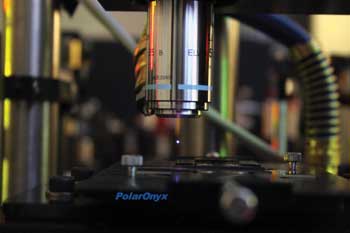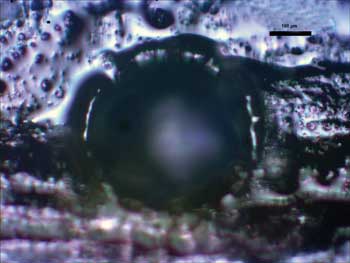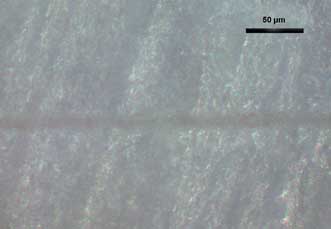As the cost:performance ratio continues to improve, a broader range of surgical applications is opening up.
Compact, lightweight and reliable, fiber lasers are taking more and more surgical procedures by storm. Femtosecond fiber lasers have emerged in the past 10 years, quickly progressing from research to development to commercialization. When compared with solid-state and gas lasers, fiber lasers offer many unique features: tremendous flexibility, convenience and reliability in surgical applications. Even for procedures for which any other laser would have been unthinkable, surgeons are beginning to make the switch to fiber lasers.
“It takes quite a long time for fiber lasers to evolve into competitive products, and only five years ago, they started to be well accepted by a variety of big markets, including marking, cutting and welding, laser weapons and biomedical applications,” said Jian Liu, president of fiber laser specialist PolarOnyx Inc. of California. “The fiber’s waveguiding properties provide single-mode operation that generates excellent diffraction-limited beam quality. This provides high resolution of focusing spot, which is especially useful in microsurgery and nanosurgery.”

Camera view of plasma (bright spot in the center) in the air ionized by PolarOnyx’s femtosecond fiber laser. High-energy femtosecond fiber lasers are emerging for microsurgery, where tissue or nerve damage must be eliminated or minimized.
As the light is delivered through a flexible fiber, the lasers allow the light to be easily integrated into surgical devices such as endoscopes and microscopes. Many fiber lasers have a wall-plug efficiency of around 30 percent. While some thulium fiber lasers have a wall-plug efficiency of around 12 percent, this is still much better than flashlamp-pumped solid-state lasers. Combine this with the supple nature of a fiber, which can be bent and coiled into a space about the size of a shoebox (about 10 times smaller than solid-state lasers of the same power) and the fiber laser becomes portable – critical for emergency surgeries.
“The most important property is that the laser beam originates within a very small fiber core, and so both high-power delivery and an excellent single-mode spatial beam profile is possible, with high brightness,” said Nathaniel Fried, associate professor in the department of physics and optical science at the University of North Carolina at Charlotte. “It is difficult to get the same high power and small, uniform single-mode spot with conventional high-power solid-state lasers currently used in surgery, such as the holmium:YAG laser.”
Fiber laser breakthroughs
Fiber lasers were first conceived in the 1980s in tandem with the development of rare-earth-doped fibers. They comprise a gain medium fiber (e.g., erbium, ytterbium or thulium) spliced with fiber Bragg gratings to form a lasing cavity. By adding an acoustic optic modulator inside the cavity, a Q-switched nanosecond pulsed fiber laser can be realized. By using a semiconductor saturation absorber as a cavity mirror, mode-locked femtosecond fiber lasers can be achieved.

Fiber lasers have myriad applications in surgical and other biomedical fields. Above, a microscopic view of beef tendon nonthermal drilling with PolarOnyx’s femtosecond fiber laser. The drilling hole diameter is 400 µm, and depth is 500 µm. Images courtesy of PolarOnyx Inc.
Today’s commercial femtosecond fiber lasers operating at energies ranging from 1 to 100 µJ and at 1 µm (ytterbium-doped fiber laser) and 1.55 µm (erbium-doped fiber laser) are sufficient for a majority of surgical applications. In terms of wavelength, mid-infrared fiber lasers operating at 2 µm (thulium-doped fiber laser) and 2.7 µm (Er:ZBLAN-doped fiber laser) are emerging as a competitive technology for laser surgery, especially in general surgery, due to the large water absorption peaks in tissues near those wavelengths.
In the past, both the price and size of femtosecond fiber lasers have held them back from certain surgical procedures. But high-energy versions are emerging as a disruptive technology for microsurgery, where the damage to surrounding tissue or nerves must be eliminated or minimized.

Fiber lasers enable ablation, cutting and other surgical procedures. Here, microscopic view of beef bone ablation. The clean and narrow ablation line is processed with PolarOnyx’s femtosecond fiber laser; the ablation linewidth is only ~5 µm.
“Recently, several breakthroughs made the femtosecond fiber lasers viable in the market,” said PolarOnyx’s Liu. “These include [the] reliable all-fiber seed oscillator, novel fiber-based dispersion management stretcher, large-mode-area high-energy fiber amplifier or photonic crystal fiber amplifier, and volume holographic grating compressor.”
New applications
While lasik is certainly the major clinical application for femtosecond fiber lasers, other emerging uses include midear surgery, bone ablation, spine surgery, cosmetic surgery, dentistry, cardiovascular surgery and oncology surgery.
The targeted nature of the laser beam is attractive to many surgeons. Fiber sources can access tricky areas of the body and deliver targeted cutting/ablating/cauterizing while minimizing damage to surrounding tissue.
For the past 10 years, Fried’s research group at UNC Charlotte has been studying the thulium fiber laser for urology applications. Although the approach is still experimental, the team proposes using a thulium fiber laser (TFL) rather than the conventional flashlamp-pumped, solid-state holmium:YAG laser for treating urinary stones.
Kidney stone disease is a common and costly disorder in the US, affecting up to 12 percent of males and 7 percent of females – and costing the national health care system around $5.3 billion every year.
“For this specific application, the single-mode fiber laser beam allows coupling of higher powers into smaller and more flexible optical fibers, which in turn frees up valuable space in the single working channel of the ureteroscope for improved saline irrigation and allows the ureteroscope to be more flexible, for reaching hard-to-reach locations, such as the lower pole of the kidney for treating stones,” Fried said.
The group found that the wavelength of the TFL (1908 nm) more closely matches a high-temperature water absorption peak in tissue than the Ho:YAG wavelength (2120 nm), which may lead to improved stone ablation.
While the Ho:YAG laser operates at higher energies, this often causes an unwanted side effect known as retropulsion, whereby laser energy tends to propel stones backward and away from the optical fiber tip, causing the surgeon to “chase” the stone, resulting in a decrease in ablation efficiency and increase in surgical time.
On the contrary, while the experimental diode-pumped TFL is limited to low pulse energies (which helps to reduce retropulsion), it is capable of operating efficiently at high pulse rates (up to 1000 Hz).
The future of surgical fiber lasers
Clinicians and researchers are not the only ones currently investing in femtosecond fiber lasers: Alcon Laboratories of Texas, Carl Zeiss Meditec of Germany, OptiMedica of California, Lutronic of South Korea and PolarOnyx are just some of the companies adopting high-energy femtosecond fiber lasers in their surgery systems.
The VisuMax laser by Carl Zeiss Meditec was introduced in 2010 as a new approach to refractive surgery for correcting myopia and myopic astigmatism. Today the list of treatments includes ReLEx – an all-femto, single-step procedure that allows surgeons to correct vision without having to create a flap in the cornea, and to perform corneal transplant procedures and intracorneal ring implantation, typically used for patients with mild to moderate myopia.
Last year, Abbott Laboratories of Abbott Park, Ill., received FDA clearance to use its iFS advanced femtosecond laser for corneal and cataract surgeries. The laser is used to create bow-shaped or curved arcuate incisions. With nearly 3 million patients undergoing cataract surgery each year in the US, such fiber lasers are helping surgeons make precise and bladeless incisions, which can be customized for each patient.
PolarOnyx is currently developing a smart “all in one” surgical tool that will image, identify and apply the appropriate surgical method. Liu said the end product will include the most compact high-energy femtosecond fiber laser and the most advanced laser-induced breakdown spectroscopic imaging system to automatically identify material such as soft tissue, hard tissue or metals and then apply the appropriate procedure (cutting, drilling or ablating, for example).
Hitting the market in the next year or so will be a 2.7-µm femtosecond fiber laser, as well as a millijoule pulse energy and kilowatt average power femtosecond fiber laser for legacy wavelengths at 1 µm, 1.55 µm and 2 µm.
“Fiber lasers almost penetrate every area. Nevertheless, femtosecond fiber lasers are finding their perfect match with surgical applications,” Liu said. “The future of ultrafast fiber lasers is beyond our imagination and without boundary.”
Beyond Lasik
Emerging clinical applications for femtosecond fiber lasers include:
• Midear surgery
• Bone ablation
• Spine surgery
• Cosmetic surgery
• Dentistry
• Cardiovascular surgery
• Oncology surgery
• Treatment of urinary stones (experimental)